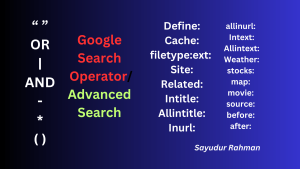What Is Email Marketing?
Email marketing is a form of digital marketing that involves sending promotional, advertising or informational messages to a target audience via email. The goal is to build relationships with customers, retain existing ones and drive sales by using personalized and targeted email campaigns.

Types Of Email Marketing:
Here are some common types of Email Marketing:
- Newsletters: Regular updates to subscribers on company news, new products, and other relevant information.
- Promotional emails: Campaigns designed to drive sales, announce new product launches, or offer discounts and special deals.
- Transactional emails: Confirmation messages, receipts, and other automated emails triggered by customer actions like making a purchase or signing up for an account.
- Abandoned cart emails: Reminder messages sent to customers who have added items to their online shopping carts but have not completed the purchase.
- Win-back emails: Re-engagement campaigns aimed at rekindling interest among inactive subscribers.
- Welcome emails: Initial messages sent to new subscribers to introduce them to a brand and start building a relationship.
- Surveys and feedback emails: Requests for customer feedback, opinions, and survey responses to improve products and services.
Importance Of Email Marketing In Digital Marketing:
Email marketing is a crucial component of digital marketing for the following reasons:
- Cost-effective: Compared to other forms of digital marketing, email marketing is relatively cheap and does not require a significant investment.
- Targeted reach: With email marketing, you can send targeted messages to specific segments of your audience based on demographics, interests, and other factors.
- High engagement rates: People check their emails regularly, making it an effective way to reach and engage with a large number of potential customers.
- Measurable results: With email marketing, it’s easy to track metrics like open rates, click-through rates, and conversion rates, allowing you to measure the success of your campaigns and make data-driven decisions.
- Personalization: Email marketing allows for personalization, which can help increase open rates and drive engagement. Personalized emails are more likely to be read and acted upon than generic, impersonal messages.
- Long-term customer relationship building: Email marketing can help establish and maintain long-term relationships with customers by regularly providing valuable content, offers, and updates.
How to learn Email Marketing:
Email marketing is a crucial component of digital marketing for the following reasons:
- Cost-effective: Compared to other forms of digital marketing, email marketing is relatively cheap and does not require a significant investment.
- Targeted reach: With email marketing, you can send targeted messages to specific segments of your audience based on demographics, interests, and other factors.
- High engagement rates: People check their emails regularly, making it an effective way to reach and engage with a large number of potential customers.
- Measurable results: With email marketing, it’s easy to track metrics like open rates, click-through rates, and conversion rates, allowing you to measure the success of your campaigns and make data-driven decisions.
- Personalization: Email marketing allows for personalization, which can help increase open rates and drive engagement. Personalized emails are more likely to be read and acted upon than generic, impersonal messages.
- Long-term customer relationship building: Email marketing can help establish and maintain long-term relationships with customers by regularly providing valuable content, offers, and updates.

How to use Email Marketing:
Here are the steps to using email marketing effectively:
- Define your target audience: Identify your target audience by considering factors such as demographics, interests, and past purchase behavior.
- Build an email list: Create a list of subscribers who have opted in to receive emails from your brand. This list can be built through sign-ups on your website, social media, or other channels.
- Choose an email service provider: Choose an email service provider (ESP) that fits your needs and budget. Some popular options include Mailchimp, Constant Contact, and Aweber.
- Create engaging content: Develop email content that is engaging, relevant, and valuable to your target audience. This could include a mix of text, images, and other multimedia elements.
- Set up automated email campaigns: Automated email campaigns allow you to send targeted messages at specific times, based on subscriber behavior or other triggers.
- Test and optimize: Test different elements of your emails, such as subject lines, calls-to-action, and email design, to see what works best. Continuously monitor and analyze the performance of your campaigns to make data-driven optimizations.
- Monitor and analyze results: Use email marketing analytics tools to track the success of your campaigns, including metrics like open rates, click-through rates, and conversion rates. Use this data to continuously improve your email marketing efforts.
Sources of Email Marketing:
Here are some common sources for building an email marketing list:
- Website sign-ups: Offer a sign-up form on your website where visitors can opt-in to receive emails from your brand.
- Social media: Use social media platforms like Facebook, Twitter, and Instagram to promote your email list and encourage followers to sign up.
- Lead magnets: Offer valuable resources, such as ebooks, whitepapers, or webinars, in exchange for an email address.
- Online events: Collect email addresses during online events, such as webinars or virtual trade shows.
- Customer database: If you have an existing customer database, you can reach out to past customers and ask if they would like to receive emails from your brand.
- In-person events: Collect email addresses at in-person events, such as trade shows or local events.
- Referrals: Encourage existing subscribers to refer friends and family to your email list.
- Purchase data: If you sell products or services online, you can collect email addresses from customers during the checkout process.
Best Software of Email Marketing:
Here are some of the most popular email marketing software:
- Mailchimp: A popular and user-friendly option that offers a free plan for small businesses and robust features for larger organizations.
- Constant Contact: Offers a wide range of features, including email automation, A/B testing, and integration with popular e-commerce platforms.
- Campaign Monitor: A platform that offers a wide range of email design tools and advanced reporting features.
- Aweber: A comprehensive email marketing platform that offers autoresponders, landing pages, and advanced reporting and analytics.
- Drip: A marketing automation platform that focuses on e-commerce businesses and offers features like personalization, dynamic content, and lead scoring.
- Sendinblue: A platform that offers a range of features, including email automation, SMS marketing, and landing pages.
- ConvertKit: An email marketing platform designed specifically for content creators and bloggers.
- Klaviyo: An e-commerce focused email marketing platform that offers advanced segmentation, personalization, and reporting.
The best software for you will depend on your specific needs, budget, and the size of your email list. It’s important to research and compare different options to find the one that best meets your requirements.

Some Email Marketing Tips:
Here are some tips for successful Email Marketing:
- Segment your list: Segment your email list into smaller, targeted groups based on factors such as demographics, interests, and past behavior. This allows you to send more relevant and personalized messages.
- Optimize your subject line: Your subject line is often the first thing your subscribers see and can make or break whether they open your email. Make sure your subject line is clear, concise, and attention-grabbing.
- Personalize your emails: Use your subscribers’ names, personalize the content based on their behavior or interests, and create a tone that speaks directly to them.
- Keep it simple: Don’t overload your emails with too much information or graphics. Stick to a clean and simple design that’s easy to read and navigate.
- Mobile optimization: Make sure your emails are optimized for mobile devices, as more and more people are checking their emails on their smartphones.
- Use a clear call-to-action: Include a clear call-to-action in every email, such as a button or link that encourages subscribers to take a specific action, like making a purchase or signing up for an event.
- Test and optimize: Continuously test different elements of your emails, such as subject lines, email content, and design, to see what resonates with your audience and optimize your campaigns accordingly.
- Monitor your results: Use email marketing analytics to track the success of your campaigns and make data-driven optimizations to improve your results.
In conclusion, email marketing is a powerful digital marketing tool that can help businesses build relationships with their customers, drive sales, and increase brand awareness. Whether you’re a small business owner or a marketer for a large corporation, the key to successful email marketing is to understand your audience, craft compelling messages, and continuously test and optimize your campaigns. With the right strategy and the right tools, email marketing can help you achieve your marketing goals and grow your business.





